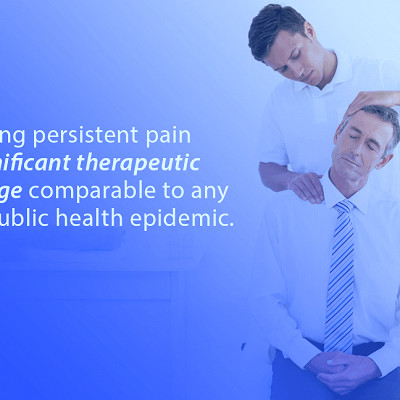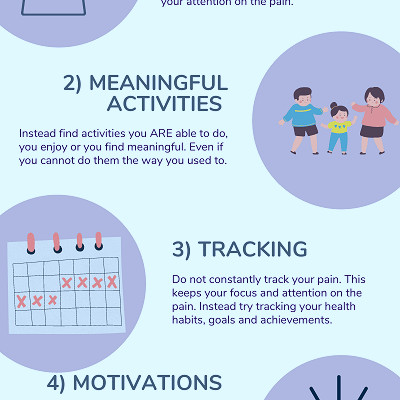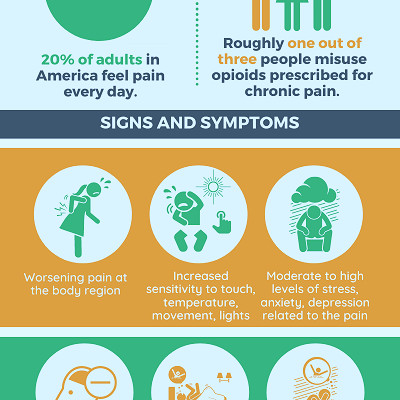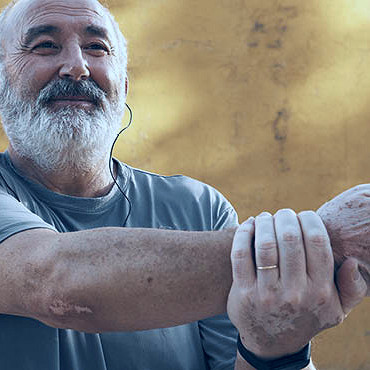 Jarlat Maletych/Shutterstock
Jarlat Maletych/Shutterstock
Features
Understanding Persistent Discomfort
Persistent discomfort is a health condition characterized by prolonged pain that lasts more than 12 weeks. It's often associated with chronic diseases such as arthritis and fibromyalgia.
The Impact of Persistent Discomfort
Persistent discomfort can significantly impair quality of life, affecting physical abilities, emotional well-being, and social interactions. It's crucial to manage this condition effectively.
The Role of Pain Perception
The perception of pain is subjective and varies significantly among individuals. Understanding this can help in tailoring pain management strategies.
Pain Management Techniques
Various techniques exist for managing persistent discomfort, including medication, physical therapy, psychological therapy, and lifestyle changes.
Medication for Persistent Discomfort
Drugs such as nonsteroidal anti-inflammatory drugs (NSAIDs), opioids, and certain antidepressants and anticonvulsants can be effective in managing persistent discomfort.
Potential Risks of Medication
While effective, these medications can have side effects and risks, including dependency. It's essential to use them under medical supervision.
Physical Therapy for Persistent Discomfort
Physical therapy can help improve mobility and strength, reducing pain. Techniques may include exercises, massage, and heat or cold therapy.
Psychological Therapy for Persistent Discomfort
Cognitive behavioral therapy (CBT) can help patients manage pain better by changing their perception and response to pain.
Lifestyle Changes for Pain Management
Regular exercise, a balanced diet, adequate sleep, and stress management can help reduce persistent discomfort.
The Role of Nutrition
Certain foods have anti-inflammatory properties that can help manage persistent discomfort. These include fruits, vegetables, whole grains, and lean proteins.
Importance of Sleep
Chronic pain can disrupt sleep, and poor sleep can exacerbate pain. Good sleep hygiene is crucial in managing persistent discomfort.
Exercise and Persistent Discomfort
Regular exercise can help reduce pain and improve overall health. It should be done under guidance to avoid exacerbating pain.
Stress and Persistent Discomfort
Chronic pain can cause stress, and stress can intensify pain. Techniques such as meditation and yoga can help manage stress.
Alternative Therapies
Some people find relief through alternative therapies such as acupuncture, chiropractic treatment, and herbal supplements.
Complementary Medicine
Complementary medicine combines conventional treatments with alternative therapies for a holistic approach to managing persistent discomfort.
The Importance of Patient Education
Educating patients about their condition and the importance of self-care can empower them to manage their pain effectively.
Personalized Treatment Plans
A personalized treatment plan that takes into account the patient's unique needs and circumstances can be more effective in managing persistent discomfort.
The Role of Support Groups
Support groups can provide emotional support and practical advice, helping individuals cope with persistent discomfort.
The Future of Pain Management
Advances in medicine, such as the development of more effective drugs and non-invasive treatments, promise better management of persistent discomfort in the future.
The Need for Ongoing Research
More research is needed to better understand persistent discomfort and develop more effective and safer treatments.
Interesting notes and facts
1. The Role of Mindfulness in Pain Management: What if we told you that your mind could be the most effective tool in managing persistent pain? Evidence suggests that mindfulness, the practice of staying present and focused, can actually help reduce pain intensity. Not only does it lower stress levels, which are often linked to pain, but it also helps you to detach from the discomfort, making it more manageable.2. Aromatherapy for Pain Relief: The use of essential oils in pain management is more than just a trend; it's backed by science. Oils like lavender, peppermint, and rosemary have been shown to provide soothing effects, helping to reduce muscle tension and inflammation. Aromatherapy can be a natural and side-effect free option to complement traditional pain relief methods.
3. The Power of Physical Activity: While it might seem counterintuitive, maintaining a regular exercise routine can actually help manage chronic pain. Exercise releases endorphins, the body's natural painkillers, and helps to strengthen muscles, reducing the strain on painful joints. Of course, it's essential to consult with a medical professional to create a safe and effective exercise plan.
4. Healthy Eating and Pain Management: They say you are what you eat, and this couldn't be more true when it comes to managing pain. A diet rich in anti-inflammatory foods like fruits, vegetables, and lean proteins can help reduce inflammation in the body, which is often at the root of chronic pain.
5. The Benefits of Massage: Whether it's performed by a professional or a loved one, a good massage can do wonders for pain management. Massage helps to reduce muscle tension, improve circulation and promote relaxation, all of which can aid in pain relief.
6. The Role of Sleep: Sleep is the body's natural restoration period, and lack of it can exacerbate pain. Ensuring a good night's sleep can help your body heal and restore, potentially reducing pain levels.
7. Mind-Body Techniques: Techniques such as yoga and tai chi integrate physical movement with mindfulness, providing both physical and psychological benefits for pain management. Regular practice can help to improve flexibility, strength, and stress levels, all contributing to better pain control.
8. The Power of Hydration: Drinking enough water is crucial for overall health, but did you know it can also aid in pain management? Dehydration can cause muscle cramps and joint stiffness, leading to increased pain. So, keep your water bottle handy!
9. Importance of Emotional Health: Chronic pain can take a toll on mental health, leading to feelings of depression, anxiety, and helplessness. Seeking support from a mental health professional, joining a support group, or practicing self-care activities can all contribute to improved emotional health and better pain management.
10. Medicinal Herbs and Spices: Some herbs and spices, like turmeric and ginger, have natural anti-inflammatory properties that can help manage pain. Incorporating these into your diet or taking them as supplements (with professional advice) can be a natural approach to pain management.
Vocabulary
- Holistic Medicine – A form of healing that considers the whole person -- body, mind, spirit, and emotions -- in the pursuit for optimal health and wellness.
- Acupuncture – An ancient Chinese medicine-based approach to treating a variety of conditions by triggering specific points on the skin with needles.
- Homeopathy – A system of alternative medicine that uses small, highly diluted doses of natural substances to trigger the body's healing abilities.
- Phytotherapy – The use of plant extracts as treatments or preventive measures for various health conditions.
- Antioxidants – Substances that can prevent or slow damage to cells caused by free radicals, unstable molecules that the body produces as a reaction to environmental and other pressures.
- Probiotics – Live bacteria and yeasts that are good for your health, especially your digestive system.
- Omega-3 Fatty Acids – Essential fats that have a wide range of benefits, including improving heart health and supporting mental health.
- Meditation – A practice where an individual uses a technique – such as mindfulness, or focusing their mind on a particular object, thought or activity – to train attention and awareness, and achieve a mentally clear and emotionally calm and stable state.
- Yoga – A mind and body practice with historical origins in ancient Indian philosophy, which involves physical postures, breathing techniques, and meditation or relaxation.
- Aromatherapy – The use of essential oils (extracted from herbs, flowers, resin, woods, and roots) in body and skin care treatments.
- Detoxification – The process of removing toxins from the body.
- Veganism – A diet and lifestyle that seeks to exclude the use of animals for food, clothing, or any other purpose.
- Gluten-Free Diet – A diet that excludes the protein gluten, which is found in grains such as wheat, barley, and rye.
- Organic Food – Food grown without the use of pesticides, synthetic fertilizers, genetically modified organisms, or ionizing radiation.
- Naturopathy – A medical system that uses natural remedies to help the body heal itself.
- Superfoods – A term used to describe food with high nutrient or phytochemical content that may confer health benefits as result.
- Ayurveda – A system of medicine with historical roots in the Indian subcontinent.
- Chiropractic – A form of alternative medicine mostly concerned with the diagnosis and treatment of mechanical disorders of the musculoskeletal system.
- Herbal Medicine – The study of the use of medicinal plants.
- Biofeedback – A process that enables an individual to learn how to change physiological activity for the purposes of improving health and performance.
- Antimicrobial Resistance – The ability of a microbe to resist the effects of medication that once could successfully treat the microbe.
- Phytonutrients – Compounds that are produced by plants ("phyto" means "plant") which have beneficial effects on humans.
- Allopathic Medicine – The branch of medical science that is considered "conventional" or "Western".
- Osteopathy – A type of alternative medicine that emphasizes physical manipulation of the body's muscle tissue and bones.
- Paleo Diet – A dietary plan based on foods similar to what might have been eaten during the Paleolithic era.
- Hydrotherapy – The use of water in the treatment of different conditions, including arthritis and related rheumatic complaints.
- Immunotherapy – The prevention or treatment of disease with substances that stimulate the immune response.
- Macronutrients – A type of food (e.g., fat, protein, carbohydrate) required in large amounts in the human diet.
- Micronutrients – A type of food required in small amounts in the human diet, such as vitamins and minerals.
- Whole Foods – Foods that are unprocessed and unrefined, or processed and refined as little as possible, before being consumed.
- Reflexology – The application of pressure to areas on the feet, hands and ears, to stimulate healing in corresponding areas of the body.
- Reiki – A therapy often described as palm healing or hands-on-body healing in which a practitioner places hands lightly on or over a patient's body to facilitate the patient's process of healing.
- GMOs – Genetically Modified Organisms. These are organisms (i.e., plants, animals or microorganisms) in which the genetic material (DNA) has been altered in a way that does not occur naturally by mating and/or natural recombination.
- Raw Food Diet – A diet consisting mostly or entirely of food that is uncooked and unprocessed.
- Flexitarian Diet – A diet that is mostly plant-based but also includes meat, dairy, eggs, poultry and fish on occasion or in small quantities.
- Cardiovascular Health – Refers to the health of the heart and blood vessels.
- Anti-Inflammatory Foods – Foods



